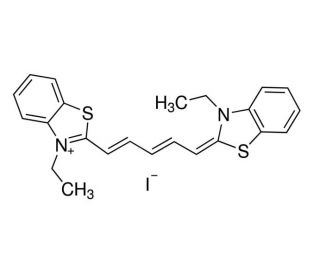

3,3'-Diethylthiadicarbocyanine iodide 的分子结构, CAS编号: 514-73-8
3,3′-Diethylthiadicarbocyanine iodide (CAS 514-73-8)
备用名:
3-Ethyl-2-[5-(3-ethyl-2(3H)-benzothiazolylidene)-1,3-pentadienyl]benzothiazolium iodide; DTDCI
应用:
3,3'-Diethylthiadicarbocyanine iodide 是一种用于荧光分析的探针
CAS号码:
514-73-8
分子量:
518.48
分子式:
C23H23IN2S2
补充资料:
此类物品属于危险品,运输时可能需要支付额外运费。
仅供科研使用。不可用于诊断或治疗。
* 参考分析证明 大量特定数据 (包括水 含量).
快捷链接
订购信息
描述
技术信息
安全信息
安全技术说明书和分析证明书
3,3'-Diethylthiadicarbocyanine iodide 是一种荧光染料,在细胞生物学和神经科学研究中用作示踪剂。它通过与细胞结构和细胞膜结合,实现对细胞和组织内特定成分的可视化和追踪。这种染料的作用机制是它能够插入脂质双分子层并选择性地染色线粒体,这可能有助于研究线粒体的动态和功能。3,3'-二乙基噻二碳菁碘化物已被用于研究各种细胞的膜电位和传输过程。它的荧光特性可用于监测膜电位和离子通量的变化,从而深入了解细胞生理学和信号传导途径。在实验应用中,这种染料在实现细胞结构和过程的可视化和分析方面发挥着重要作用。
3,3′-Diethylthiadicarbocyanine iodide (CAS 514-73-8) 参考文献
- 使用羰花青染料区分突触体中浆膜和线粒体膜电位的变化。 | Hare, MF. and Atchison, WD. 1992. J Neurochem. 58: 1321-9. PMID: 1548466
- 光动力作用对离子通过含有氧化修饰脂质的脂质体膜泄漏的影响。 | Ytzhak, S. and Ehrenberg, B. 2014. Photochem Photobiol. 90: 796-800. PMID: 24588634
- 中尺度纳米粒子可选择性地靶向肾近曲小管上皮细胞。 | Williams, RM., et al. 2015. Nano Lett. 15: 2358-64. PMID: 25811353
- 利用多分支金纳米粒子和表面增强拉曼散射改进分子指纹分析。 | Johnston, J., et al. 2016. Int J Nanomedicine. 11: 45-52. PMID: 26730189
- 低功率常压冷等离子体的抗菌功效和作用机制:膜渗透性, 生物膜渗透和抗菌敏化。 | Brun, P., et al. 2018. J Appl Microbiol. 125: 398-408. PMID: 29655267
- 离体牛肾上腺髓质细胞的刺激-分泌耦合。 | Knight, DE. and Baker, PF. 1983. Q J Exp Physiol. 68: 123-43. PMID: 6402798
- 花青染料的光化学特性。第 1 部分.-3,3′-二乙基氧杂羰花青碘化物和 3,3′-二乙基硫杂羰花青碘化物 | Dempster, D. N., Morrow, T., Rankin, R., & Thompson, G. F. 1972. Journal of the Chemical Society, Faraday Transactions 2: Molecular and Chemical Physics. 68: 1479-1496.
- 聚甲基染料的光物理过程。3, 3'-diethylthiadicarbocyanine iodide 的吸收, 发射和光声研究 | Bilmes, G. M., Tocho, J. O., & Braslavsky, S. E. 1989. The Journal of Physical Chemistry. 93(18): 6696-6699.
- 利用干涉相干拉曼散射测定液相中的阻尼分子旋转 | Kozich, V. P., Lau, A., Pfeiffer, A. M., & Kummrow, A. 1999. Journal of Raman spectroscopy. 30(6): 473-477.
- 一种快速, 廉价的方法,用于检测欧洲鳗鲡肠刷状缘膜囊泡中短链肽的运输。 | Verri, T., Danieli, A., Bakke, S., Romano, A., Barca, A., RÖnnestad, I.,.. & Storelli, C. 2008. Aquaculture Nutrition. 14(4): 341-349.
- 用于荧光检测白蛋白的氮杂取代方肽酶 | Volkova, K. D., Kovalska, V. B., Losytskyy, M. Y., Reis, L. V., Santos, P. F., Almeida, P.,.. & Yarmoluk, S. M. 2011. Dyes and Pigments. 90(1): 41-47.
- 醇盐和胶束水溶液中均对称羰花青的扭转和重新定向运动:3,3′-二乙基噻二碳菁碘化物 | Dandapat, M., Ghosh, D., & Mandal, D. 2014. Journal of Photochemistry and Photobiology A: Chemistry. 276: 41-49.
- 在共敏化染料敏化太阳能电池中设计全色响应的花青染料分子工程学 | Pepe, G., Cole, J. M., Waddell, P. G., & McKechnie, S. 2016. Molecular Systems Design & Engineering. 1(1): 86-98.
订购信息
| 产品名称 | 产品编号 | 规格 | 价格 | 数量 | 收藏夹 | |
3,3′-Diethylthiadicarbocyanine iodide, 1 g | sc-214161 | 1 g | $82.00 |
